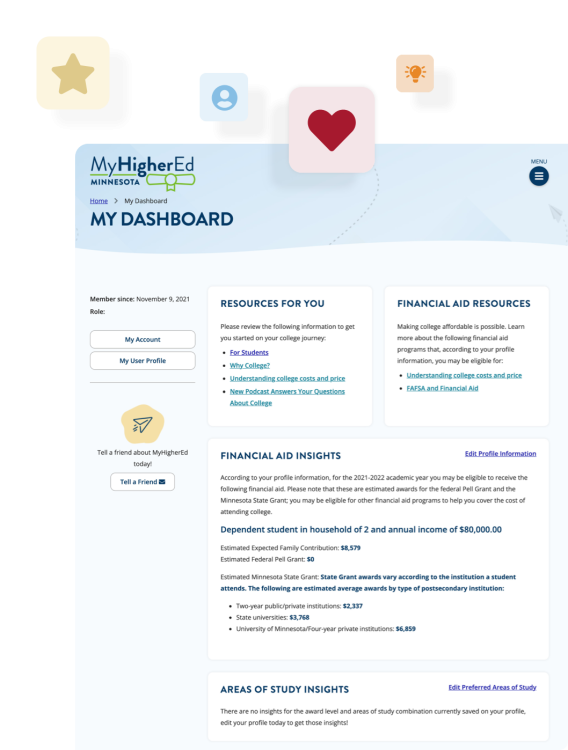Data used on MyHigherEd.MN.gov is compiled from several sources.
The College Search Tool provides information and reported data for postsecondary institutions in Minnesota that are either:
- Licensed and registered by the Office of Higher Education
- A Minnesota State Colleges and Universities campus, or
- A campus of the University of Minnesota
College Profile
Information provided in this section has been submitted and reported by the institution in the fall of academic year 2023-2024. When available, data shows the total number of students enrolled, the number of graduate students, plus the demographic details for undergraduate students attending an institution.
Totals represent unduplicated head counts at an institution (students enrolled at more than one institution are counted once per institution). Counts less than 10 have been suppressed to protect student privacy. Percentage points have been rounded up and may not add up to 100%.
Data Source: Minnesota Office of Higher Education
Cost
Information provided in this section includes the estimated cost of attendance for full-time beginning undergraduate students, as reported by the institution to the Minnesota Office of Higher Education and the Department of Education. Cost of attendance includes tuition, books, room and board, and transportation. This data is used by the financial aid office to determine a student’s financial need and eligibility for federal financial aid. In addition, you may find information about net price, which is the amount students actually pay for college after grants and scholarships have been applied. Net price data shows the average amount paid by first-time, full-time, undergraduate students, as reported by the institution. When available, the section will also display average annual net price by family income.
For licensed private institutions, this section may display the average annual tuition, which is the amount of tuition and required fees covering a full academic year for students in undergraduate programs. This value represents what a typical student would be charged and may not be the same for all students at an institution.
Data sources: Minnesota Office of Higher Education and the Integrated Postsecondary Education Data System (IPEDS), academic years 2021-2022 (net price data) and 2021-2022 (cost of attendance) .
Financial Aid
Data displayed on this section shows the reported number of undergraduate students at the institution receiving Minnesota State grants, federal grants, and other state financial aid, including the average amount of financial aid awarded to full-time first-time undergraduate students during the 2022-2023 academic year. Finally, when available this section displays the cumulative median debt of students graduating at the institution, if eligible to participate in a Minnesota-funded financial aid program.
Data sources: Minnesota Office of Higher Education and the Integrated Postsecondary Education Data System (IPEDS).
Student Success
Data displayed on this section shows the reported percent of new undergraduate students at the institution who continued to enroll in the next academic year and persisted through their studies until completion of their program. This section also displays graduation rates at the institution by type of credential within 150% on-time completion. For students pursuing a bachelor’s degree, 150% on-time completion is six years; for students
pursuing an associate degree or a sub-baccalaureate certificate, 150% on-time completion is three years.
Data sources: Minnesota Office of Higher Education and the Integrated Postsecondary Education Data System (IPEDS), 2023.
Cumulative Debt
Data displayed on this section shows the median amount of debt incurred by a student while attending a specific institution and pursuing a specific postsecondary credential. The debt figures include debt from federal, state, and private sources that is known to the institutions. Debt figures do not include any debt incurred from previous institutions, and students who graduate with no debt are not included in the median.
Data source: Minnesota Office of Higher Education, 2023.
Admissions Information
Information provided in this section pertains to the institution's published admissions requirements and considerations, which may include the institution's acceptance of dual credit courses (PSEO and Concurrent Enrollment) and exam-based credit (Advanced Placement, International Baccalaureate, and CLEP). Additionally, the institution may be identified for awarding credit for previous military training and offering programs and courses that lead to career advancement included in the Minnesota Department of Employment and Economic Development's Eligible Training Providers List.
Data sources: Minnesota Office of Higher Education, Credit Survey, SIMON, Minnesota Department of Employment and Economic Development, and the Integrated Postsecondary Education Data System (IPEDS), 2022-2023.
Award Levels
A college profile also shows information about award levels offered by a Minnesota postsecondary institution according to specific Areas of Study. The areas of study listed on the website correspond to the Classification of Instructional Programs (CIP), a taxonomic coding scheme of primarily postsecondary instructional programs categorized by major field of study to create standard classifications for reporting purposes. The award levels listed for an institution were reported to the Minnesota Office of Higher Education via the postsecondary institutional survey.
Data Source: Minnesota Office of Higher Education
Graduate Employment Outcomes
The data shown pertaining to graduate employment outcomes provides percent of graduates with full-time employment in the 3rd year after college graduation and the median annual wages by award level, according to the Minnesota unemployment insurance records. Data does not include federal employees, self-employed, military, or individuals who moved out of state for a job.
The purpose of including employment outcomes data on MyHigherEd is to present a picture of what an average graduate from a specific college or postsecondary institution earns after graduation. If the data available data does not reflect a minimum of 50% of the graduates from an institution's graduating class, the data has been removed. This 50% criteria has been applied to all postsecondary institutions with graduate employment outcomes data on MyHigherEd.
Data source: Minnesota Department of Employment and Economic Development (Class of 2021)

